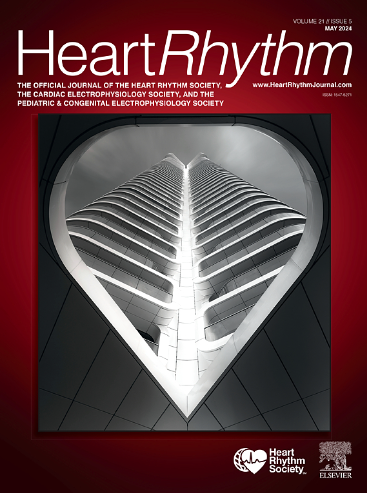在起搏 QRS 的尾部进行起搏:其机制是什么?
IF 5.6
2区 医学
Q1 CARDIAC & CARDIOVASCULAR SYSTEMS
引用次数: 0
摘要
植入双腔起搏器次日的心电图显示,有两个间隔 100 毫秒的紧密耦合起搏尖峰,后者位于起搏 QRS 波群的后缘。这种紧密耦合起搏脉冲的鉴别诊断包括心房导联移位、脉冲发生器上的导联反转、心房后心室空白期的室性早搏复极以及捕获丢失后的备用起搏脉冲。通过对起搏器定时间隔的批判性分析,找到了问题的机制和病因。本文章由计算机程序翻译,如有差异,请以英文原文为准。
Pacing on the tail of paced QRS: What is the mechanism?
An electrocardiogram on the day after implantation of a dual-chamber pacemaker revealed 2 closely coupled pacing spikes at 100-ms intervals, with the latter being on the trailing edge of the paced QRS complex. Differential diagnoses of such closely coupled pacing pulses include atrial lead displacement, lead reversal on the pulse generator, ventricular premature complex in the post-atrial ventricular blanking period, and backup pacing pulse following a loss of capture. Critical analysis of the pacemaker timing intervals led to the mechanism and cause of the problem.
求助全文
通过发布文献求助,成功后即可免费获取论文全文。
去求助
来源期刊

Heart rhythm
医学-心血管系统
CiteScore
10.50
自引率
5.50%
发文量
1465
审稿时长
24 days
期刊介绍:
HeartRhythm, the official Journal of the Heart Rhythm Society and the Cardiac Electrophysiology Society, is a unique journal for fundamental discovery and clinical applicability.
HeartRhythm integrates the entire cardiac electrophysiology (EP) community from basic and clinical academic researchers, private practitioners, engineers, allied professionals, industry, and trainees, all of whom are vital and interdependent members of our EP community.
The Heart Rhythm Society is the international leader in science, education, and advocacy for cardiac arrhythmia professionals and patients, and the primary information resource on heart rhythm disorders. Its mission is to improve the care of patients by promoting research, education, and optimal health care policies and standards.
 求助内容:
求助内容: 应助结果提醒方式:
应助结果提醒方式:


